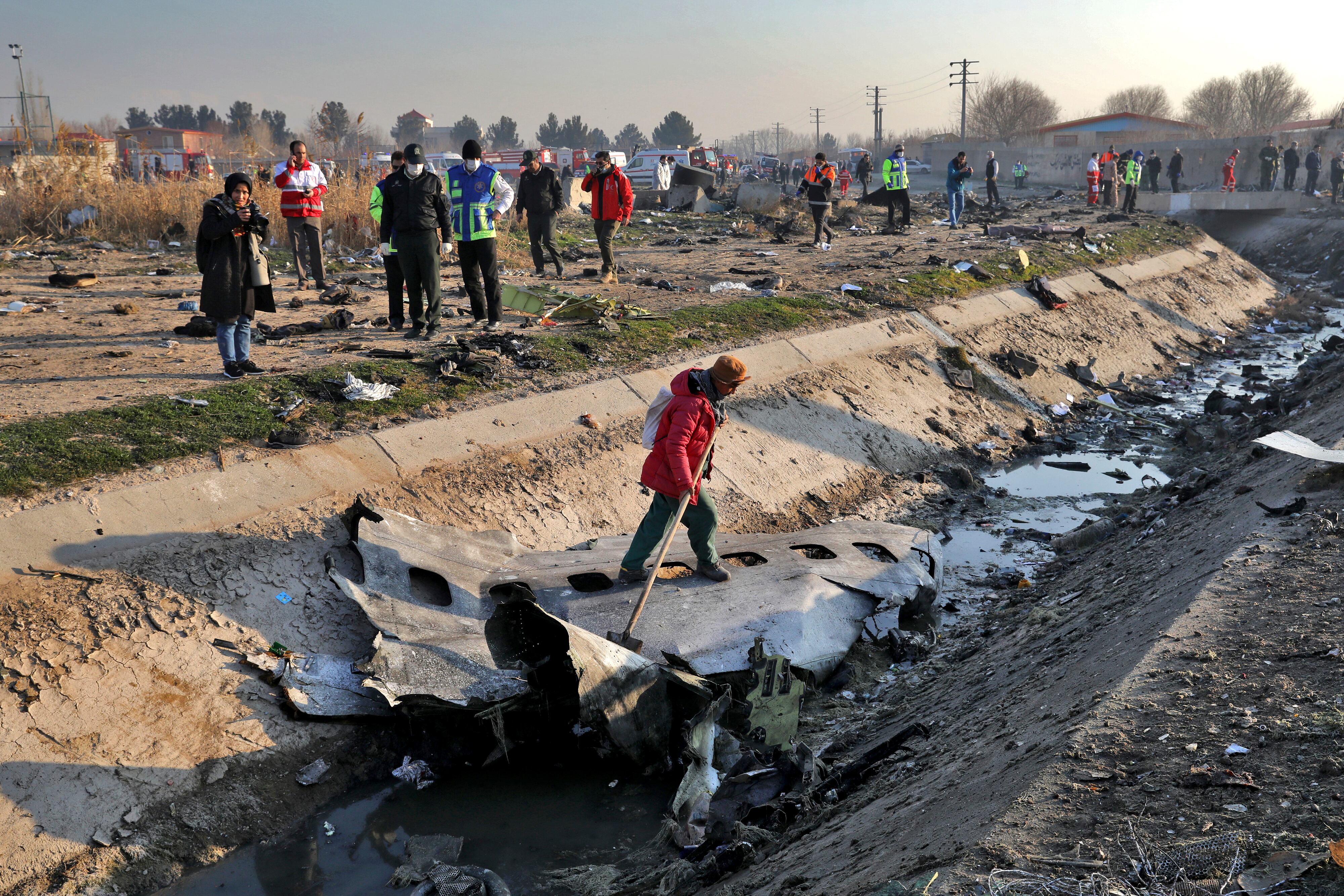TEHRAN, Iran — The crew of a Ukrainian jetliner that crashed in Iran, killing all 176 people on board, never made a radio call for help and were trying to turn back for the airport when their burning plane went down, an initial Iranian investigative report said Thursday. Ukraine, meanwhile, said it considered a missile strike as one of several possible theories for the crash, despite Iran’s denials.
The Iranian report suggests that a sudden emergency struck the Boeing 737 operated by Ukrainian International Airlines early on Wednesday morning, when it crashed, just minutes after taking off from Imam Khomeini International Airport in Tehran.
Investigators from Iran's Civil Aviation Organization offered no immediate explanation for the disaster, however. Iranian officials initially blamed a technical malfunction for the crash, something initially backed by Ukrainian officials before they said they wouldn't speculate amid an ongoing investigation.
The crash came just a few hours after Iran launched a ballistic missile attack against Iraqi military bases housing U.S. troops amid a confrontation with Washington over it killing an Iranian Revolutionary Guard general in a drone strike last week.
Oleksiy Danilov, secretary of Ukraine's Security Council, told Ukrainian media that officials had several working theories regarding the crash, including a missile strike.
"A strike by a missile, possibly a Tor missile system, is among the main (theories), as information has surfaced on the internet about elements of a missile being found near the site of the crash," Danilov said. He did not elaborate on where he saw the information on the internet.
Ukrainian investigators that arrived in Iran earlier on Thursday currently await permission from Iranian authorities to examine the crash site and look for missile fragments, Danilov said.
The Ukrainian International Airlines took off at 6:12 a.m. Wednesday, after nearly an hour's delay at Tehran's Imam Khomeini Airport, the main airport for travelers in Iran. It gained altitude heading west, reaching nearly 8,000 feet, according to both the report and flight-tracking data.
Then something went wrong, though “no radio messages were received from the pilot regarding unusual situations,” the report said. In emergencies, pilots typically immediately contact air-traffic controllers.
Eyewitnesses, including the crew of another flight passing above it, described seeing the plane engulfed in flames before crashing at 6:18 a.m., the report said.
The crash caused a massive explosion when the plane hit the ground, likely because the aircraft had been fully loaded with fuel for the flight to Kyiv, Ukraine.
The report also confirmed that both of the so-called “black boxes” that contain data and cockpit communications from the plane had been recovered, though they sustained damage and some parts of their memory was lost. It also said that investigators have initially ruled out laser or electromagnetic interference as causing the crash.
The Tor is a Russian-made missile system. Russia delivered 29 Tor-M1s to Iran in 2007 as part of a $700 million contract signed in December 2005. Iran has displayed the missiles in military parades as well.
Iran did not immediately respond to the Ukrainian comments. However, Gen. Abolfazl Shekarchi, the spokesman of the Iranian armed forces, denied a missile hit the airplane in a comments reported Wednesday by the semiofficial Fars news agency. He dismissed the allegation as "psychological warfare" by foreign-based Iranian opposition groups.
Ukraine has a grim history with missile attacks, including in July 2014 when one such strike downed a Malaysian Airlines flight over eastern Ukraine, killing all 298 people aboard.
Danilov also said other possible causes under consideration included a drone or another flying object crashing into the plane, a terrorist attack or an engine malfunction causing an explosion. However, no terror group has claimed responsibility for the attack.
The plane was carrying 167 passengers and nine crew members from several countries, including 82 Iranians, at least 63 Canadians and 11 Ukrainians, according to officials. The crash just before dawn scattered flaming debris and passengers’ belongings across a wide stretch of farmland.
Many of the passengers were believed to be international students attending universities in Canada; they were making their way back to Toronto by way of Kyiv after visiting with family during the winter break.
Ukrainian President Volodymyr Zelenskiy said he planned to call Iranian President Hassan Rouhani about the crash and the investigation.
“Undoubtedly, the priority for Ukraine is to identify the causes of the plane crash,” Zelenskiy said. “We will surely find out the truth.”
Canadian Prime Minister Justin Trudeau said 138 of the passengers were bound for Canada.. The flight also included a family of four and newlyweds, too. The manifest listed several teenagers and children, some as young as 1 or 2.
The crash ranked among the worst losses of life for Canadians in an aviation disaster. The flag over Parliament in Ottawa was lowered to half-staff, and Trudeau vowed to get to the bottom of the disaster.
“Know that all Canadians are grieving with you,” he said, addressing the victims’ families.
Ukrainian officials, for their part, initially agreed with Iranian suspicions that the 3½-year-old plane was brought down by mechanical trouble but later backed away from that and declined to offer a cause while the investigation is going on.
While the cause of the tragedy remained unknown, the disaster could further damage Boeing’s reputation, which has been battered by the furor over two deadly crashes involving a different model of the Boeing jet, the much-newer 737 Max, which has been grounded for nearly 10 months. The uproar led to the firing of the company’s CEO last month.
Boeing extended condolences to the victims’ families and said it stands ready to assist.
___
Gambrell reported from Dubai, United Arab Emirates, and Litvinova from Moscow.





